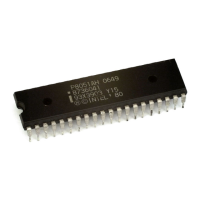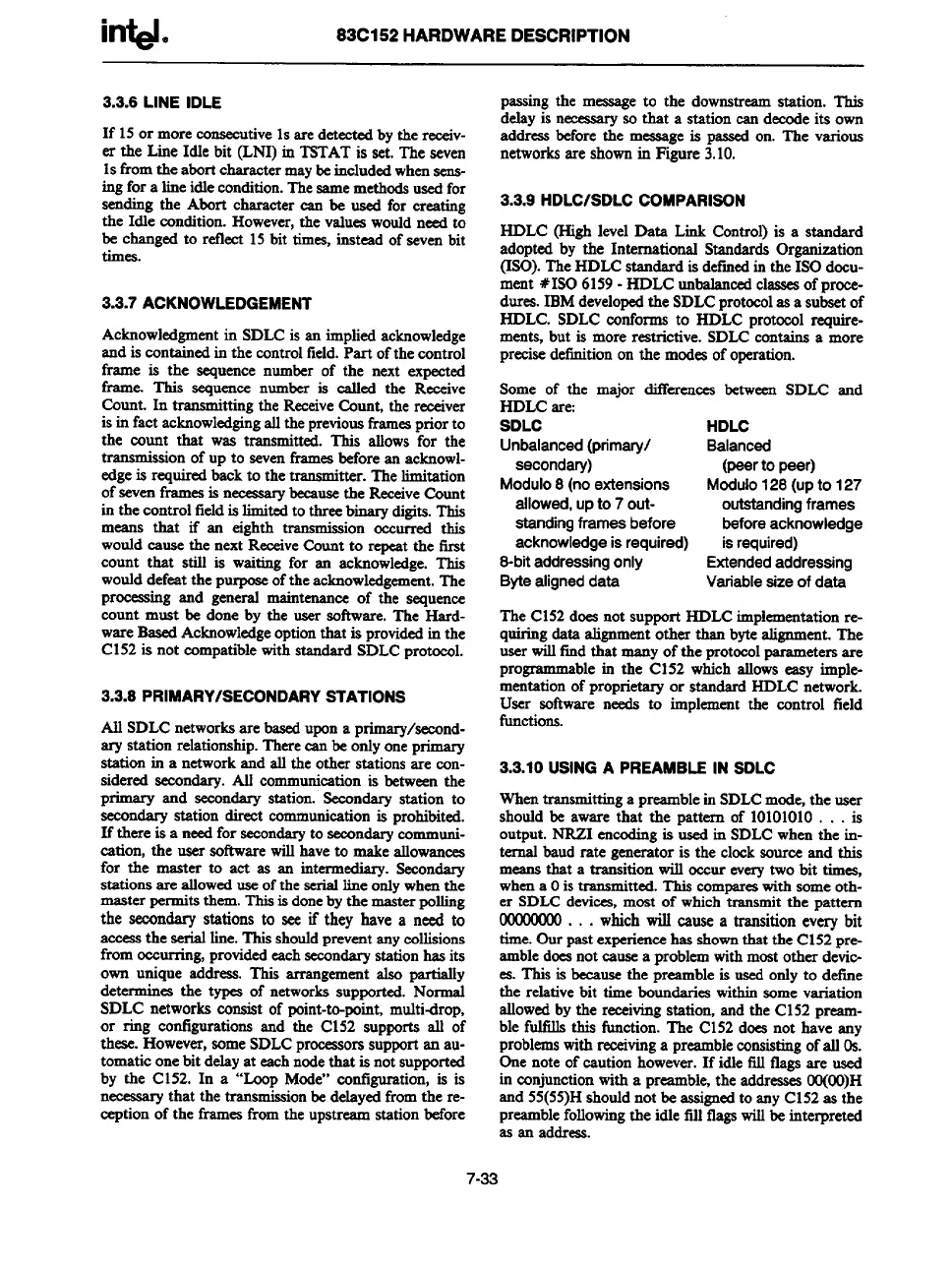i~e
83C152 HARDWARE DESCRIPTION
3.3.6 LINE IDLE
If 15or morec
onsecutive1sare detectedbythe receiv-
er the Line Idle bit (LNI) in TSTATis set. Tbe seven
Is fromthe abortcharactermaybe includedwhensens-
ingfor a lineidlecondition.Thesamemethodsusedfor
sending the Abort character can be used for creating
the Idle condition.However,the valueswouldneedto
be changedto reflect 15bit times,instead of severebit
times.
3.3.7 ACKNOWLEDGEMENT
Acknowledgmentin SDLCis an impliedacknowledge
andis containedin the mntrol field.Part ofthecontrol
frame is the sequence number of the next expected
frame. This sequence number is called the Receive
Count. In transmi “
ttmg the ReceiveCount,the receiver
is in fact acknowledgingall thepreviousframesprior to
the count that was transmitted. This allows for the
transmissionof up to sevenframesbeforean acknowl-
edgeis requiredbackto the transmitter. The limitation
ofsevenframesis necemarybecausethe ReceiveCount
in the controlfieldis limitedto threebinarydigits.This
means that if an eighth
tmmmisaion occurred this
wouldcausethe next ReceiveCountto repeat the tirst
count that still is waiting for an acknowledge.This
woulddefeatthe purposeofthe acknowledgement.The
P
roceasingand general
maintenanceof the sequence
count must be done by the user software.The Hard-
wareBasedAcknowledgeoptionthat is providedin the
C152is not compatiblewithstandard SDLCprotocol.
3.3.8 PRIMARY/SECONDARY STATIONS
All
SDLCnetworksare basedupona pritnsry/secmd-
ary station relationship.Therecanbe onlyoneprimary
station in a networkand all the other stationsare con-
sidered wxdat-y. All cormmmiestionis betweenthe
primary and secondary station. Secondarystation to
secondarystation direct communicationis prohibited.
If there is a needfor secondaryto secondarycomrmmi-
cation, the user softwarewillhaveto make allowances
for the master to act as an intermediary.Secondary
stationsare atlowestuseofthe seriatlineonlywhenthe
master permitsthem.Thisisdonebythe masterpolling
the secondary stations to see if they have a need to
accessthe serialline.Thisshouldpreventanycollisions
fromoecurnng,providedeachsecondarystationhas its
own unique address. This arrangement also partially
determm‘ ea the types of networkssupported. Normal
SDLC networks
consist of point-to-point,multidrop,
or ring cotttigurationsand the C152 supports all of
these.However,someSDLCproceasors supportan au-
tomaticonebit delayat eachnodethat is notsupported
by the C152.In a “Loop Mode” configuration,is is
neeessmythat the transmissionbedelayedfromthe re-
ceptionof the framesfromthe upstreamstationbefore
passingthe messageto the downstreamstation. This
delayis neceasmy
so that a station csn decodeits own
addressbefore the messageis passedon. The various
networksare shownin Figure 3.10.
3.3.9
HDLCISDLC COMPARISON
HDLC (High level Dsta Link Control)is a standard
adopted by the International StandardsOrganization
(IsO). TheHDLC standardis definedin the 1S0docu-
ment r#ISO6159- HDLC unbalancedclassesofproce-
dures.IBMdevelopd the SDLCprotocolas a subsetof
HDLC. SDLCconforms to HDLC protocol require-
ments,but is more restrictive. SDLCcontainsa more
precisedefinitiononthe modesofoperation.
Some of the major differences between SDLC and
HDLC are:
SDLC
HDLC
Unbalanced(primary/ Balanced
secondary) (peerto peer)
Modulo8 (noextensions
MOdUiO 128 (Up to 127
allowed,upto 7 out-
outstendingframes
standingframesbefore beforeacknowledge
acknowledgeisrequired)
isrequired)
8-bitaddressingonly Extendedaddressing
Bytealigneddata VSrieblesizeof data
TheC152doesnot support HDLC implementationre-
quiringdata alignmentother than bytealignment.The
userwilltind that manyof the protocolparametersare
programmablein the C152 which allowseasy imple-
mentationof proprietaryor standardHDLC network.
User sotlware needs to implement the control field
functions.
3.3.10 USING A PREAMBLE IN SDLC
Whentransmitting
a preamblein SDLCmode,the user
shouldbe aware that the pattern of 10101010. . . is
output. NRZI encodingis usedin SDLCwherethe in-
ternal baudrate generatoris the clocksourw and this
meansthat a transition will oear everytwo bit time+
whena Ois t
ransmitted.This compareswithsomeoth-
er SDLCdevices,most of whichtransmit the pattern
OOMKOOO. . . which will cause a transitionevery bit
time.Our pastexperiencehasahownthat the C152pre-
ambledoesnot causea problemwithmostother devic-
es. This is becausethe preambleis usedonlyto define
the relativebit time boundarieswithinsome variation
allowedbythe receivingstation, and the C152pream-
ble fulfillsthis function.The C152dces not have any
problemswithreceivinga preambleconsistingofall 0s.
Onenote of cautionhowever.If idle fill flagsare used
in conjunctionwitha preamble,the addressesCO(OO)H
and 55(55)Hshouldnot be assignedto anyC152as the
preamblefollowingthe idle fill flagswillbe interpreted
as artaddress
7-33

